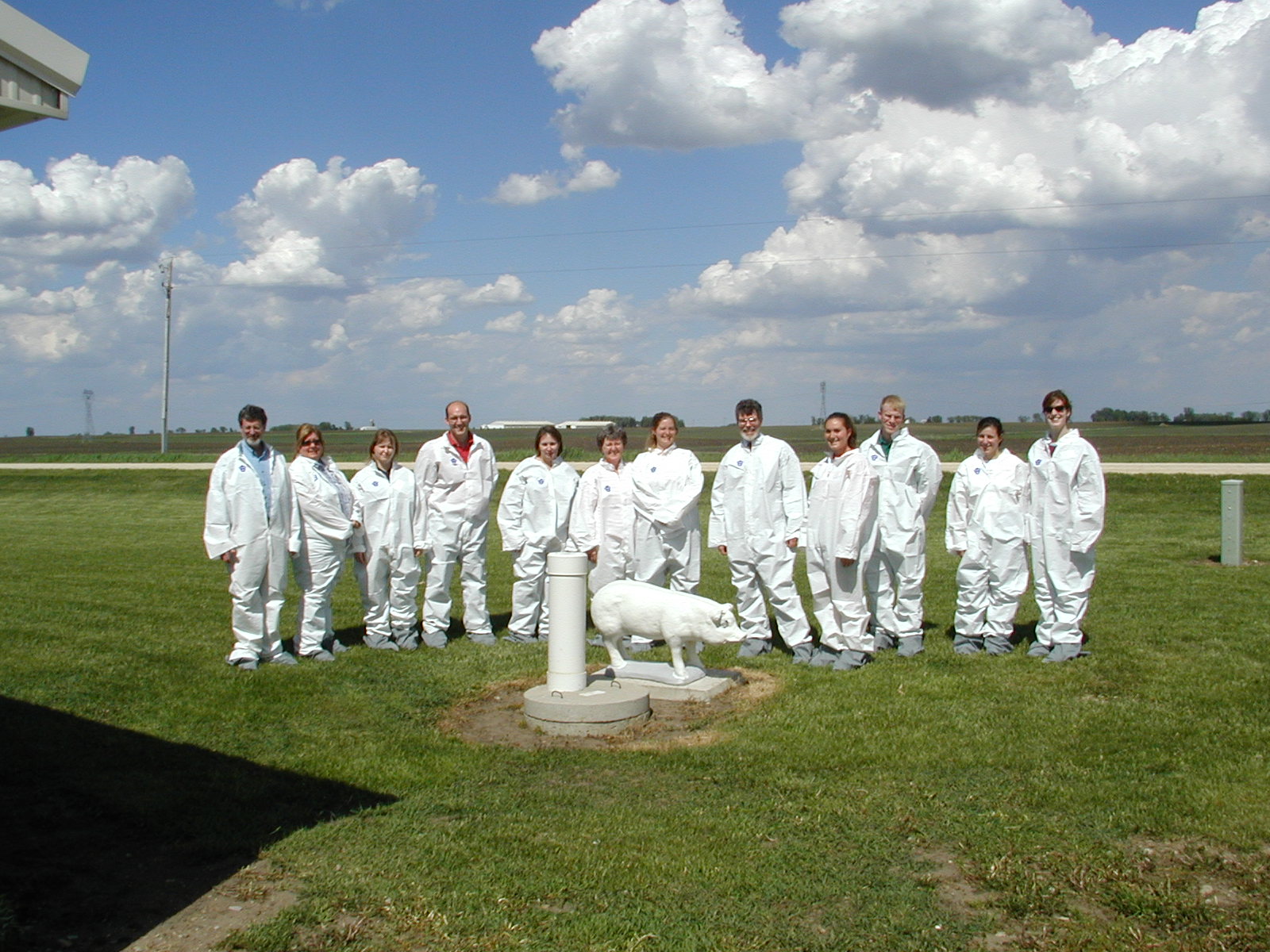
Participants of the 2002 Farm to Table program in Minnesota
Background
The Center for Animal Health and Food Safety (CAHFS) grew out of two high-profile public health issues related to animal health and food safety. The first, and outbreak of E. coli traced to Jack in the Box restaurants, occurred in 1993. It was the largest E. coli outbreak in American history at the time, killing four people and sickening hundreds of others.
The second incident occurred a few years later, when scientists recognized a new human disease: variant Creutzfeldt Jakob disease, which is related to bovine spongiform encephalopathy, or mad cow disease. Both high profile public health issues sent shock waves through the agricultural community and consumers.
The events convinced Minnesota policy makers, government agencies, veterinarians, and public health officials that these groups need to work together to combat emerging threats to food safety.
In 2001, the College of Veterinary Medicine responded by forging partnerships with the College of Food, Agricultural and Natural Resource Sciences; Extension Service; School of Public Health; and Medical School. With the aid of $500,000 from the Minnesota legislature, the Center for Animal Health and Food Safety was launched. Will Hueston, DVM, PhD, became the first director of CAHFS.
Growth and Development
CAHFS has expanded considerably since 2001. Initially the Center had one full time faculty member and one full time staff employee. Now, the Center engages 15 veterinary public health faculty and 7 staff members as well as graduate students, residents, fellows, and senior fellows. Funding has also increased. In only 10 years between 2006-2016, more than $17 million was raised in grants, gifts, affiliation agreements, and external sales.
Since 2001, several initiatives and organizations have grown out of CAHFS, including:
- Public Health Institute, a three-week program offering courses from faculty and leading experts, for individuals practicing in or studying public health and related fields.
- Veterinary public health and preventive medicine (VPHPM) residency program, a two-year residency for early- to mid-career veterinarians to gain specialized training in veterinary public health practice.
- Food Protection and Defense Institute, which focuses on anticipating and preventing intentional food safety outbreaks.
- Safe Supply of Affordable Food Everywhere (SSAFE), which fosters the continuous improvement and global acceptance of internationally recognized food protection systems and standards.
- Global Initiative for Food Systems Leadership (GIFSL), which delivers leadership development programs that empower food systems professionals to work collaboratively.
- Dual-degree Doctor of Veterinary Medicine/Master of Public Health (DVM/MPH) program, for students who want to work at the interface of human wellness and animal health.
- Endowed Chair of Global Animal Health and Food Safety, funded through a partnership with Cargill and the University of Minnesota.
- Chiang Mai University Twinning project, an OIE Veterinary Twinning Programme which identified curriculum gaps by comparison to the OIE’s guidelines for veterinary education core curriculum.
- Food Policy Research Center, an initiative to improve public and legislative decision-making through the dissemination of information about agriculture and food-related policy with fact sheets and policy analyses.
- University of Prishtina, Kosovo Transformational Leadership Project, a partnership with the University of Prishtina Faculty of Agriculture (UP FA) which has created workshops, courses, and faculty development fellowships to strengthen the skills important to develop Kosovo’s economy.
- Upper Midwest Agricultural Safety and Health Center (UMASH), a multi-year grant program directed toward improving the health and safety of agricultural workers and their families.
- ProgRESSVet, an innovative educational initiative delivered predominantly online, that aims to increase the capacity of veterinary services in Spanish-speaking Latin America.
These many initiatives have allowed CAHFS to accomplish its core mission of creating and facilitating strong working relationships among food systems professionals & organizations, governmental entities, public agencies, and academia, to anticipate emerging animal health and food safety issues affecting public health.
Leadership
The Center for Animal Health and Food Safety has been expertly guided throughout the years by:
- William Hueston, DVM, PhD: 2001-2007
- Jeffrey Bender, DVM, PhD: 2007-2012
- Linda Valeri, MBA: 2012-2016
- Scott Wells, DVM, PhD: 2012-2017
- Andrés Perez, DVM, PhD: 2017 – present
By the Numbers
Through a variety of in-person, online, experiential learning, training, and graduate courses, CAHFS has delivered expert learning experiences to a wide range of students, faculty, professionals, researchers, and practitioners.
DVM/MPH Program
- 132 total graduates
- 19 participating institutions
- 137 currently enrolled students
VPHPM Residency Program
- 41 residents completed program
- 34 completed MPH degree
- 93% ACVPM board certified
Performance of Veterinary Service
- 15 graduate courses
- 150+ student participants
- 20 faculty experts
Experiential Learning Programs
- 75 programs delivered
- 10+ countries visited
In total...
2,176 participants from 60+ countries
Check out a timeline of our accomplishments on our History page
